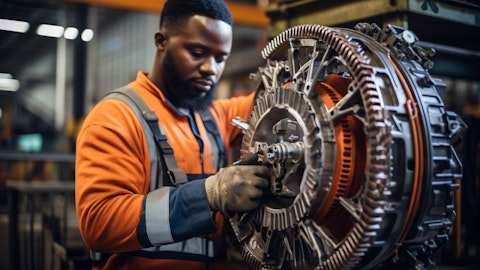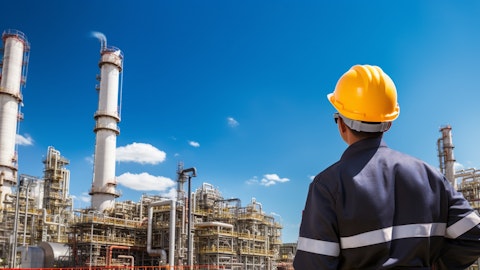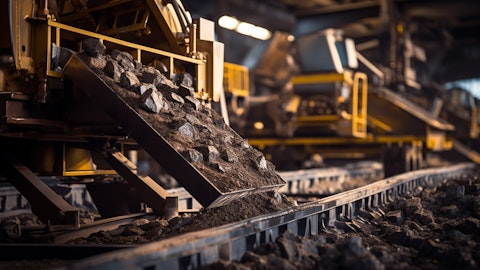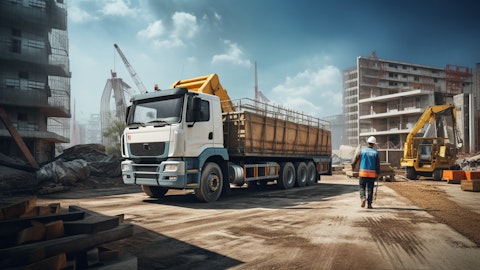Compañía de Minas Buenaventura S.A.A. (NYSE:BVN) Q1 2025 Earnings Call Transcript May 1, 2025
Operator: Good morning, ladies and gentlemen. Welcome to the Compania de Minas Buenaventura First Quarter 2025 Earnings Results Conference Call. [Operator Instructions] And please note that this call is being recorded. I would now like to introduce your host for today’s call, Mr. Sebastian Valencia, Head of Investor Relations. Mr. Valencia, you may begin.
Sebastian Valencia : Good morning, and thank you for joining us today to discuss our first quarter 2025 results. Today’s discussion will be led by Mr. Leandro Garcia, Chief Executive Officer. Also joining our call today and available for your questions are Mr. Daniel Dominguez, Chief Financial Officer; Mr. Juan Carlos Ortiz, Vice President of Operations; Mr. Aldo Massa, Vice President of Business Development and Commercial; Mr. Alejandro Hermoza, Vice President of Sustainability; Mr. Renzo Macher, Vice President of Projects; Mr. Juan Carlos Salazar, Vice President of Geology and Exploration; and Mr. Roque Benavides, Chairman; and Mr. Raul Benavides, Director. Before I hand the call over, let me first touch on a few items. On Buenaventura’s website, you will find our press release that was posted yesterday after market close.
Please note that today’s remarks include forward-looking statements and that are based on management’s current views and assumptions. While management believes that these assumptions, expectations and projections are reasonable in view of the currently available information, you are cautioned not to place undue reliance on these forward-looking statements. I encourage you to read the full disclosure concerning forward-looking statements within the earnings results press release issued in April 30, 2025. Let me now turn the call to Mr. Leandro Garcia.
Leandro Garcia : Thank you, Sebastian. Good morning, and thank you for joining us today to discuss the quarterly results of the company. On Slide 2 is our cautionary statement, important information that I encourage you to read. Today, we will be discussing our performance for the first quarter of 2025, highlighting key achievements and strategies moving forward. After the presentation, we will be available for a Q&A session, where our team will be happy to answer your questions. Next slide, please. I would like to highlight a few key areas that contribute to our strong first quarter 2025 results. Our first quarter 2025 EBITDA from direct operations was $126 million compared to $95 million reported in the first quarter of 2024.
This performance is also reflected in a higher EBITDA margin of 41% compared to 38% in the previous year. First quarter 2025 net income was $140 million compared to $61 million in net income for the first quarter of last year. The year ended with a cash position of $648 million and a total debt of $862 million, resulting in a net leverage ratio of 0.46x. This debt level increased against the previous quarter as it includes Buenaventura 2032 notes. It also considers only the outstanding amount of our 2026 notes. The total CapEx for the quarter amounted to $36 million with $22 million allocated to the San Gabriel project. On April 23, 2025, Buenaventura received $49 million in dividends related to its stake in Cerro Verde. In the first quarter of 2025, silver production reached 3.7 million ounces, 20% higher compared to the 3.1 million ounces producing during the same period of last year.

Of this total, 2.2 million ounces came from Yumpag due to full-scale operation. Copper production decreased 21% year-over-year, primarily due to the remaining El Brocal open pit inventories, which were processed in the first quarter of 2024. And gold production was 27,980 ounces compared to 36,593 ounces produced in the first quarter of 2024, primarily due to the decreased production at Tambomayo and Orcopampa, partially offset by increased production at La Zanja. Finally, consolidated reserves have been updated as of the end of 2024. Gold reserves have increased by 482,000 ounces. Silver reserves have increased by 61 million ounces and copper reserves have increased by 253,000 tonnes. Moving on to our cost structure in Slide 4. The all-in sustaining cost for the first quarter of 2025 decreased by 83% compared to the same period in the previous year.
It is important to highlight that the year-over-year decrease in all-in sustaining cost was primarily driven by lower commercial deductions and higher byproduct credits. Moving on the cost applicable to sales trend. As you can see, copper cash cost applicable to sales increased year-over-year, mainly due to lower byproduct credit contributions at El Brocal. Silver cash has increased year-over-year, but was consistent with the expectations for this quarter. Gold cash has increased year-over-year, primarily driven by lower volumes in grades at Tambomayo and Orcopampa. On the next slide, we will present free cash flow generation. The first quarter 2025 cash position increased during the quarter, mainly driven by net cash inflows from financial activities.
An additional $100 million was raised through the bond issued in February ’25 and the remaining amount of the 2026 bond. In addition to these drivers, the EBITDA to free cash flow reconciliation reflects Buenaventura’s significant CapEx investment related to San Gabriel. Moving on to Slide 6. This slide shows San Gabriel’s cumulative progress, reaching 79% overall completion by the first quarter 2025, primarily driven by finishing the engineering and procurement as well as the construction 75% of advance. At March 2025, San Gabriel’s total CapEx has reached $505 million. The guidance for the full year 2025 has been revised to the range of $220 million-$250 million. The construction time line remains on schedule. We anticipate commencing the ramp-up phase in the third quarter of 2025, followed by the production of the first gold bar in the fourth quarter of 2025.
However, this milestone remains subject to the timely approval to the necessary permits. On the next slide, we are showing the processing plants progress that will operate at 3,000 tonnes per day. Currently, the primary crusher mechanical works are at 100%. The SAG and Ball mechanical works are at 98%. And finally, the CIL tanks mechanical works are at 97%. Moving on, we can see the progress of the main components of the plant. Moving on Slide 9, we are showing the progress at the filtered tailings plant that currently is at 74%. To conclude the presentation, I would like to share a few final thoughts. San Gabriel continues to advance steadily with 79% overall progress and on track to produce its first gold bar in the fourth quarter of 2025.
Yumpag is proving to be a key growth driver, delivering 2.3 million ounces of silver in the first quarter and generating a strong cash flow. We are also driving growth by increasing our gold, silver and copper reserves, led by the strength of our flagship operations. And finally, our focused strategy remains unchanged. We are committed to our corporate guidelines, prioritizing reserve growth, EBITDA maximization and cost efficiency at our flagship mines and in our strong pipeline of projects. Thank you for your attention. I will hand the call back to the operator to open the line for questions. Operator, please go ahead.
Q&A Session
Follow Compania De Minas Bv Sa (NYSE:BVN)
Follow Compania De Minas Bv Sa (NYSE:BVN)
Receive real-time insider trading and news alerts
Operator: [Operator Instructions] Today’s first question comes from Carlos De Alba with Morgan Stanley.
Carlos De Alba: So on San Gabriel, maybe I’ll group some together. So the CapEx increase in 2025, is this — does this represent an increase on the overall CapEx of the project or just a shifting maybe from what you would expect to invest in 2026 and maybe you’re investing it now in 2025? If you could clarify that would be great. And given the CapEx that we’re discussing now going up, what is the new expected return on this investment that you see as you get closer to completion? And what permits are pending that may prevent you from starting production this year? But assuming that you get those permits, what would be the range of production that you see for 2025 and maybe 2026 out of San Gabriel? And my second question is if you could maybe give us a reminder of the exploration budget, the exploration expense that you spend to run through your P&L, both for operating units and nonoperating units in 2025.
And if you can also comment on the general and administrative expenses, they came a little bit higher in the first quarter. How do you see that line also for the year as well as SG&A?
Leandro Garcia : Thank you, Carlos, for your question. Regarding San Gabriel, is the CapEx to be executed in 2025. There are some geotechnical and hydraulic issues that Renzo will explain to you further. In terms of the return, remember that this project was decided to go on with prices of $1,600. So it will maintain the same profitability for the company. In terms of the permits, we are referring to the construction authorization that — sorry, the operation authorization that will be granted once we finish the construction. Renzo, I don’t know if you want to — yes.
Carlos De Alba: Maybe Leandro, can you remind us what exactly is the return on the profitability that you are seeing for San Gabriel? And just to clarify, what is now the total CapEx for the project that you see after the increase in 2025?
Leandro Garcia : The total CapEx should be between $720 million and $750 million.
Carlos De Alba: Okay. And the IRR of the project or the net present value of the project?
Leandro Garcia : It’s around 12%, 13%.
Operator: [Operator Instructions] I apologize.
Leandro Garcia : Yes, there are a couple of questions, and the answer for — from Renzo. And also, there are a couple of questions on exploration expenses and the G&A. We can begin with Renzo.
Renzo Macher: Yes. So in regards to the problems we have with geotech and hydrogeology as well as some excess inadequate material beyond our confidence level. Those problems have been resolved, but we require some additional work in the form of slope reinforcement, additional layers of grouting in the water dam to find a place to temporarily place this excess inadequate inventory and add some excess quarry production to compensate. So all those things have been already done or are in the process of being completed. And that was the — where are we going to be spending all this money besides these excess works, we have like $45 million in finishing the electrical and mechanical and commissioning of the plant, the tailings storage facility, another $25 million, the mine development, another $35 million and the power line, another $50 million. We are maintaining our committed date for the first gold bar in the fourth quarter at this point.
Leandro Garcia : We can — thank you, Renzo. We can continue with the exploration expenses and investment.
Daniel Dominguez: Yes, Leandro. This is Daniel. Thank you, Carlos, for your question. In terms of exploration, we can divide it in two kind of explorations. The first one is the explorations in the operating units. This is basically for infill drilling to convert the resources into reserves. The normalized amount for the quarters, the next quarters is in the order of $10 million to $12 million. For the overall year 2025, we are in the order of $40 million to $45 million. In addition to this, we have the nonoperating areas of explorations, which will be in the order of $4 million to $5 million each quarter. For the entire 2025, we should be in the order of $20 million. One of the most important activities here is the exploration in El Brocal within the areas of Unish and Bohorquez.
Regarding the administrative expenses, yes, as you mentioned, it is – they are a little bit higher than we were expecting. But this is basically due to the higher workers’ participation that we are registering because of the higher profits that we report from our direct operations. The amount of administrative expenses for each quarter this year will be in the order of $15 million to $17 million. For the entire year, we expect around $60 million to $65 million.
Operator: [Operator Instructions] Our next question today comes from Tanya Jakusconek with Scotiabank.
Tanya Jakusconek: Maybe, Daniel, I’m just going to finish off with you just on some of the forecasting. Can you remind me now what your capital expenditure is going to be for this year? Previously, we had $330 million to $355 million. I’m just wondering if that is still valid with this movement in the San Gabriel capital.
Daniel Dominguez: Tanya, we expect an increase in the CapEx, as Renzo mentioned, San Gabriel will add some additional CapEx for the construction of San Gabriel. We expect for this year in total around $400 million to $420 million. From this, we have already spent more than $80 million.
Tanya Jakusconek: Okay. And maybe just so I understand the delta, I think it’s come in $50 million more than Gabriel, $50 million or thereabout more than we expected from the original budget of Q4. Can you just remind me that $50 million, what was the overrun?
Renzo Macher: Okay. So the overrun of it was based on this inadequate material and the hydrogeological underneath the water dam basically. So we have to move a lot more inadequate material to the new storage area. We need to do several additional layers of grouting. And obviously, this scrambled a little bit the coordination between the contractors. So we are in that process of accelerating certain activities to maintain the date of the first gold bar. That’s kind of what was out of the scope.
Tanya Jakusconek: Okay. So maybe just for myself to understand, when you talk about inadequate material, are you talking about waste rock?
Renzo Macher: No. I’m talking about like quarries, quarries that were supposed to have like good building material, we found some layers of inadequate material.
Tanya Jakusconek: Okay. And so you have to move the facility to another place. Is that a correct understanding?
Renzo Macher: No. We need to remove all that inadequate material in order to reach the foundation level, and we need to expand our existing inadequate material deposit to hold these additional quantities.
Tanya Jakusconek: Okay. And is this a water storage facility? I’m just trying to understand what’s going to be placed on top of that.
Renzo Macher: No. This is where the filtration plant is. The water storage facility has a different issue. Yes. No, the water storage facility had some infiltration problems. So we — initially, we expected to do kind of a couple of layers of grouting, but we ended up putting like 7 layers of grouting. That took some time, and we’re going to be reinforcing the size of the water dam as well. At this point, the dam is kind of 35% of its total height so far. We already finished the rainy season. So we’re starting to see some increase speed in that.
Tanya Jakusconek: Okay. So it’s two different things, the filtration plant and the water dam. Got it. Okay. Can I then ask what we are going to — you talked a lot about the open — what’s happening on surface at San Gabriel. So I’ve talked a lot about the mill. Can we go to the underground? So where are we now on the underground with respect to, #1, the training of the underground miners? #2, where are we with respect to stop development, i.e., getting them ready for production? And #3, where are we on the stockpile on surface? And are we still on target to be at that 300,000 tonnes by October? So just those 3 on San Gabriel.
Leandro Garcia : Thank you. Maybe Juan Carlos can help us with the answers.
Juan Carlos Ortiz: Sure, Leandro. Well, regarding training, we are hiring the new crews for Buenaventura in order to be ready by the end of July that we work our first delivery of equipment — underground equipment. So Epiroc is going to deliver our first crew on a schedule, July, August, September and the last crew, the last fleet on October. So we have hired the first crew and the second is on the process of being hired, and we are training them. We have the Tambomayo mine using these mining methods right now. So we are bringing the executive, the engineers, the supervisors to Tambomayo. They are being trained there in order to know all the details about the mining method under current field. So it’s part of the process. We are on track of doing that.
Regarding the stop development, we are opening according to the plan, the galleries across the ore body. We have right now in the order of 60,000 tonnes of material ore on surface. So it’s according to the plan. Right now, we have the contractor, [indiscernible] with 3 fleets on site with the capabilities on doing between 600 meters to 800 meters per month. It depends what kind of ground we need to cross each month. So we need to put like steel reinforcement, probably more close to the 600 meters per month. And if we have another month where we only can advance with shotcrete, probably closer to the 800 meters per month. So depending on the schedule of each month, we are in that range with the contractor. And in July, we will have our first crew of Buenaventura on site.
Tanya Jakusconek: Okay. So it looks like everything is going to plan. And I know we talked about the ground conditions in your previous conference call that you were requiring concrete cement required and obviously, reinforcement is little water, so you didn’t have water underground. Are you still seeing similar ground conditions, nothing worse?
Juan Carlos Ortiz: Yes. It’s what expected. It’s what we call rock mass Category 4 is [indiscernible]. It need to be supported with steel arches. In some cases, we have a little bit better rock, it’s called Category 3B that can be developed only with shotcrete and bolts.
Tanya Jakusconek: Okay. And then just my final question, if I can ask on Coimolache. I know we were expecting permits in Q1, so we could start construction in Q2 and resume fresh ore leaching in Q3. Do we know where we are on — have we gotten the permits? And have we started construction?
Juan Carlos Ortiz: Leandro, you allow me?
Leandro Garcia : Yes.
Juan Carlos Ortiz: Yes. We were granted the construction permit in March. We started construction in April. We are starting construction right now of the expansion of the pad. While at the same time, we are asking for stockpiling fresh ore on top of the existing stock on the existing pad. So we have 2 permits running in parallel, one for the lateral expansion of the pad and one for piling more ore on top of the existing one. So we are according to the plan. We expect to pile fresh ore on top of the pad by August this year. So after we put the ore in there, probably you need to wait 60 days in order to allow the solution to came all the way down to the human brain and report to the extraction facility. So we start placing ore in August, will be September, October, late October, early November that we will start seeing an increase in gold production in Coimolache.
Operator: Our next question today comes from Alex Hacking with Citi.
Alex Hacking: I just wanted to clarify on San Gabriel, I apologize. When you talk about the water dam, are you — is that the TSF? Is that where the tailings are being deposited?
Renzo Macher: No. So water dam is where we’re going to be storing fresh water to use in the plant. The tailings storage facility, it’s a different component, and it’s going to be dry stacking.
Alex Hacking: Okay. So I just want to clarify that. And so — when you talk about the geotechnical and hydraulic issues, those are exclusively — and the CapEx overrun, is it exclusively related to that water dam or there are other issues as well?
Renzo Macher: Yes. The water dam had some — the infiltration that we found underneath the foundation was not according to the — what our original study had. So we have to do a lot more of grouting, yes. We thought that 2 to 3 layers of grouting will be enough. We ended up with 7 layers of grouting. And we reached the infiltration rate — the design infiltration rates. That’s one problem. The other problem, it’s a quarry that was supposed to have enough material for filling, didn’t have enough material. It was inadequate material. So we need to move it to reach the foundation level of that quarry and then replace it with another quarry. So that causes some scrambling of the contract — of the construction sequence that we are currently aligning again.
Alex Hacking: Okay. That’s helpful. And then I guess the follow-up question, I guess, around the transition to operating yourself at Uchucchacua, Yumpag, Brocal, I guess, any update on how that process is going?
Juan Carlos Ortiz: Leandro, allow me to answer that part of the question.
Leandro Garcia : Yes, sure.
Juan Carlos Ortiz: Yes. We already assigned the contract, the purchase order for Uchucchacua, Yumpag and Brocal to Sandvik. We have a schedule for bringing all the equipment on board. In the case of Uchucchacua and Yumpag, because our midsized equipment, they are going to be delivered earlier basically in the third and fourth quarter of this year. Only a small fraction of the equipment will be delivered early in 2026. We will replace all equipment, we will return any rental equipment that we have on the ground. So to give a more continuity of operations underground. We will have also full service of Sandvik on site from day 0. In the case of El Brocal, most of the equipment will be delivered on 2026 because this is a very large size of equipment, large loaders and large production drills.
So most of the equipment will be delivered by early 2026 in the first and second quarter. Again, the strategy there is to save cost by doing the work by ourselves at a larger size. We have right now with the contractor loaders that are only 10 tonnes capacity, and we are moving into different size of equipment more close to between 14 for development, 14 tonnes loader for development and 17 tonnes for production to extract the ore from the stopes. So that’s the reason we are doing that in El Brocal, and again, it’s going to be with Sandvik with the same strategy with full maintenance from day 0 on site.
Operator: Thank you. That concludes the question-and-answer session of today’s conference call. I would now like to turn it back over to Leandro Garcia for closing remarks.
Leandro Garcia: Thank you, operator. Before we conclude today’s conference call, I would like to thank you for the time and effort dedicated to joining us. Your participation and input are greatly appreciated. Thank you very much, and have a wonderful day.
Operator: Ladies and gentlemen, that concludes Buenaventura’s First Quarter 2025 Earnings Results Conference Call. We would like to thank you again for your participation. You may now disconnect.
Follow Compania De Minas Bv Sa (NYSE:BVN)
Follow Compania De Minas Bv Sa (NYSE:BVN)
Receive real-time insider trading and news alerts





